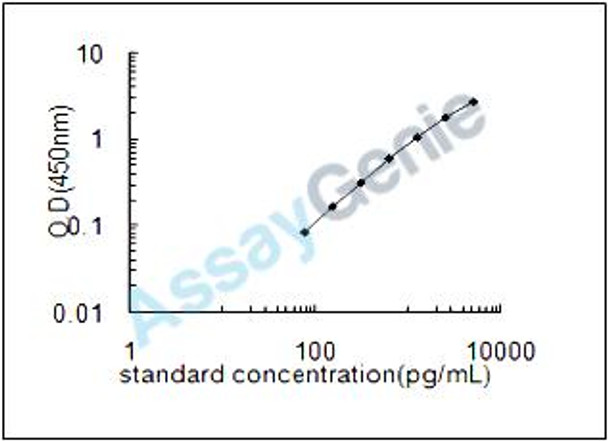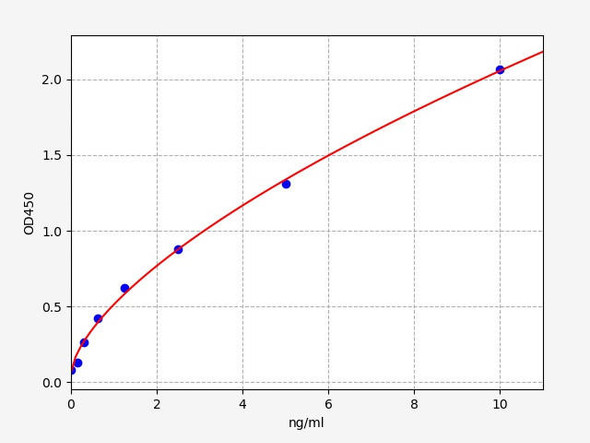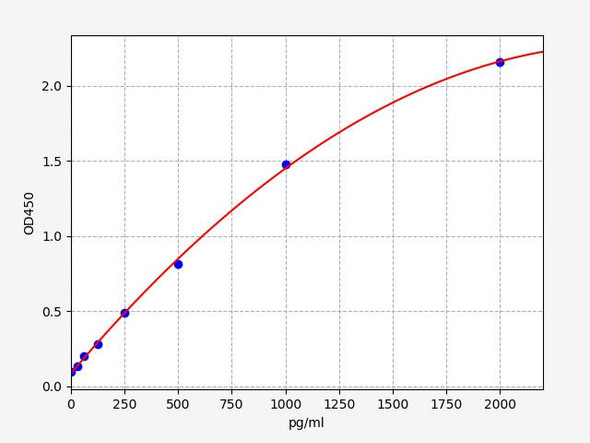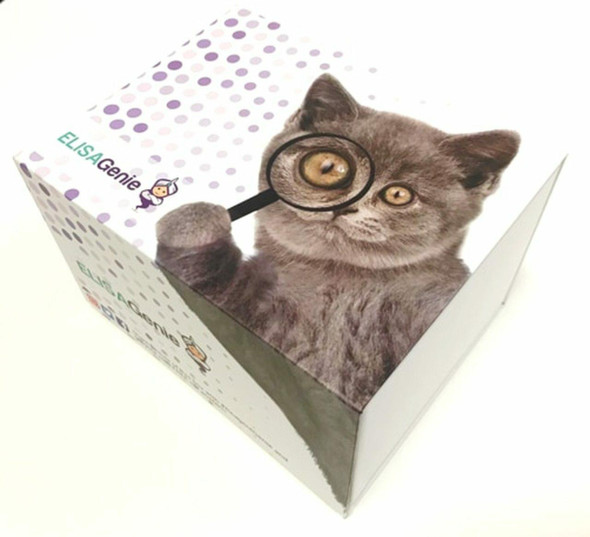Rat Disintegrin and metalloproteinase domain-containing protein 17 (Adam17) ELISA Kit (RTEB0870)
- SKU:
- RTEB0870
- Product Type:
- ELISA Kit
- Size:
- 96 Assays
- Uniprot:
- Q9Z1K9
- ELISA Type:
- Sandwich
- Reactivity:
- Rat
Description
Rat Disintegrin and metalloproteinase domain-containing protein 17 (Adam17) ELISA Kit
The Rat ADAM17 (Disintegrin and Metalloproteinase Domain-containing Protein 17) ELISA Kit is a valuable tool for researchers looking to accurately measure levels of ADAM17 in rat serum, plasma, and cell culture supernatants. This kit offers high sensitivity and specificity, ensuring dependable and consistent results for a variety of experimental purposes.ADAM17 is a critical enzyme involved in cell signaling and the shedding of membrane-bound proteins, playing a key role in processes such as inflammation, tissue remodeling, and cell proliferation. Dysregulation of ADAM17 has been implicated in various diseases, including cancer, inflammatory disorders, and cardiovascular conditions, making it a valuable target for scientific investigation and potential therapeutic interventions.
By utilizing the Rat ADAM17 ELISA Kit, researchers can gain valuable insights into the role of ADAM17 in disease pathogenesis and explore its potential as a biomarker for diagnostic and therapeutic purposes. Trust in the accuracy and reliability of this kit to advance your research in the field of molecular biology and disease mechanisms.
| Product Name: | Rat Disintegrin and metalloproteinase domain-containing protein 17 (Adam17) ELISA Kit |
| SKU: | RTEB0870 |
| Size: | 96T |
| Target: | Rat Disintegrin and metalloproteinase domain-containing protein 17 (Adam17) |
| Synonyms: | TNF-alpha convertase, TNF-alpha-converting enzyme, CD156b, ADAM 17, Tace |
| Assay Type: | Sandwich |
| Detection Method: | ELISA |
| Reactivity: | Rat |
| Detection Range: | 78-5000pg/mL |
| Sensitivity: | 39.8pg/mL |
| Intra CV: | Provided with the Kit |
| Inter CV: | Provided with the Kit |
| Linearity: | Provided with the Kit |
| Recovery: | Provided with the Kit |
| Function: | Cleaves the membrane-bound precursor of TNF-alpha to its mature soluble form. Responsible for the proteolytical release of soluble JAM3 from endothelial cells surface (By similarity). Responsible for the proteolytic release of several other cell-surface proteins, including p75 TNF-receptor, interleukin 1 receptor type II, p55 TNF-receptor, transforming growth factor-alpha, L-selectin, growth hormone receptor, MUC1 and the amyloid precursor protein. Acts as an activator of Notch pathway by mediating cleavage of Notch, generating the membrane-associated intermediate fragment called Notch extracellular truncation (NEXT). Plays a role in the proteolytic processing of ACE2. |
| Uniprot: | Q9Z1K9 |
| Sample Type: | Serum, plasma, tissue homogenates, cell culture supernates and other biological fluids |
| Specificity: | Natural and recombinant rat Disintegrin and metalloproteinase domain-containing protein 17 |
| Sub Unit: | Interacts with MAD2L1, MAPK14 and MUC1. |
| Research Area: | Neurosciences |
| Subcellular Location: | Membrane Single-pass type I membrane protein |
| Storage: | Please see kit components below for exact storage details |
| Note: | For research use only |
| UniProt Protein Function: | TACE: a type I membrane protein with disintegrin and metalloprotease activity. An ubiquitously expressed ectoenzyme of peptidase family M12B. Must be membrane anchored to cleave the different substrates. The cytoplasmic domain is not required for the this activity. Possesses a narrow endopeptidase specificity. Cleaves Pro-Leu-Ala-Gln-Ala-|-Val-Arg-Ser-Ser-Ser in the membrane-bound, 26-kDa form of tumor necrosis factor alpha (TNF-alpha) to its mature soluble form. Responsible for the proteolytic release of several other cell-surface proteins, including p75 TNF-receptor, interleukin 1 receptor type II, p55 TNF-receptor, transforming growth factor-alpha, L-selectin, and the amyloid precursor protein. Also involved in the activation of Notch pathway. Binds 1 zinc ion per subunit. Two splice variant isoforms have been described. |
| UniProt Protein Details: | Protein type:EC 3.4.24.86; Membrane protein, integral; Motility/polarity/chemotaxis; Protease Chromosomal Location of Human Ortholog: 6q16 Cellular Component: actin cytoskeleton; apical plasma membrane; cell surface; cytoplasm; cytosol; extracellular space; focal adhesion; integral component of membrane; integral component of plasma membrane; intercellular junction; membrane; membrane raft; plasma membrane Molecular Function:integrin binding; interleukin-6 receptor binding; metal ion binding; metalloendopeptidase activity; metallopeptidase activity; Notch binding; PDZ domain binding; SH3 domain binding Biological Process: B cell differentiation; cell adhesion; cell adhesion mediated by integrin; cell motility; defense response to Gram-positive bacterium; epidermal growth factor receptor signaling pathway; germinal center formation; integrin-mediated signaling pathway; membrane protein ectodomain proteolysis; negative regulation of apoptosis; negative regulation of neuron projection development; negative regulation of transforming growth factor beta receptor signaling pathway; Notch receptor processing; Notch signaling pathway; PMA-inducible membrane protein ectodomain proteolysis; positive regulation of cell growth; positive regulation of cell migration; positive regulation of cell proliferation; positive regulation of cellular component movement; positive regulation of chemokine production; positive regulation of cyclin-dependent protein serine/threonine kinase activity involved in G1/S transition of mitotic cell cycle; positive regulation of epidermal growth factor-activated receptor activity; positive regulation of protein phosphorylation; positive regulation of T cell chemotaxis; positive regulation of transforming growth factor beta receptor signaling pathway; production of molecular mediator of acute inflammatory response; proteolysis; regulation of axon regeneration; regulation of mast cell apoptotic process; regulation of neuron migration; response to drug; response to high density lipoprotein stimulus; response to hypoxia; response to lipopolysaccharide; spleen development; T cell differentiation in thymus; wound healing, spreading of epidermal cells |
| NCBI Summary: | expression occurs in response to oxygen glucose deprivation, may play a role in inhibition of apoptosis via induction of TNF-alpha release [RGD, Feb 2006] |
| UniProt Code: | Q9Z1K9 |
| NCBI GenInfo Identifier: | 9945330 |
| NCBI Gene ID: | 57027 |
| NCBI Accession: | NP_064702.1 |
| UniProt Related Accession: | Q9Z1K9 |
| Molecular Weight: | 93,017 Da |
| NCBI Full Name: | disintegrin and metalloproteinase domain-containing protein 17 |
| NCBI Synonym Full Names: | ADAM metallopeptidase domain 17 |
| NCBI Official Symbol: | Adam17 |
| NCBI Official Synonym Symbols: | TACE |
| NCBI Protein Information: | disintegrin and metalloproteinase domain-containing protein 17 |
| UniProt Protein Name: | Disintegrin and metalloproteinase domain-containing protein 17 |
| UniProt Synonym Protein Names: | TNF-alpha convertase; TNF-alpha-converting enzyme; CD_antigen: CD156b |
| Protein Family: | Disintegrin and metalloproteinase domain-containing protein |
| UniProt Gene Name: | Adam17 |
| Component | Quantity (96 Assays) | Storage |
| ELISA Microplate (Dismountable) | 8×12 strips | -20°C |
| Lyophilized Standard | 2 | -20°C |
| Sample Diluent | 20ml | -20°C |
| Assay Diluent A | 10mL | -20°C |
| Assay Diluent B | 10mL | -20°C |
| Detection Reagent A | 120µL | -20°C |
| Detection Reagent B | 120µL | -20°C |
| Wash Buffer | 30mL | 4°C |
| Substrate | 10mL | 4°C |
| Stop Solution | 10mL | 4°C |
| Plate Sealer | 5 | - |
Other materials and equipment required:
- Microplate reader with 450 nm wavelength filter
- Multichannel Pipette, Pipette, microcentrifuge tubes and disposable pipette tips
- Incubator
- Deionized or distilled water
- Absorbent paper
- Buffer resevoir
*Note: The below protocol is a sample protocol. Protocols are specific to each batch/lot. For the correct instructions please follow the protocol included in your kit.
Allow all reagents to reach room temperature (Please do not dissolve the reagents at 37°C directly). All the reagents should be mixed thoroughly by gently swirling before pipetting. Avoid foaming. Keep appropriate numbers of strips for 1 experiment and remove extra strips from microtiter plate. Removed strips should be resealed and stored at -20°C until the kits expiry date. Prepare all reagents, working standards and samples as directed in the previous sections. Please predict the concentration before assaying. If values for these are not within the range of the standard curve, users must determine the optimal sample dilutions for their experiments. We recommend running all samples in duplicate.
| Step | |
| 1. | Add Sample: Add 100µL of Standard, Blank, or Sample per well. The blank well is added with Sample diluent. Solutions are added to the bottom of micro ELISA plate well, avoid inside wall touching and foaming as possible. Mix it gently. Cover the plate with sealer we provided. Incubate for 120 minutes at 37°C. |
| 2. | Remove the liquid from each well, don't wash. Add 100µL of Detection Reagent A working solution to each well. Cover with the Plate sealer. Gently tap the plate to ensure thorough mixing. Incubate for 1 hour at 37°C. Note: if Detection Reagent A appears cloudy warm to room temperature until solution is uniform. |
| 3. | Aspirate each well and wash, repeating the process three times. Wash by filling each well with Wash Buffer (approximately 400µL) (a squirt bottle, multi-channel pipette,manifold dispenser or automated washer are needed). Complete removal of liquid at each step is essential. After the last wash, completely remove remaining Wash Buffer by aspirating or decanting. Invert the plate and pat it against thick clean absorbent paper. |
| 4. | Add 100µL of Detection Reagent B working solution to each well. Cover with the Plate sealer. Incubate for 60 minutes at 37°C. |
| 5. | Repeat the wash process for five times as conducted in step 3. |
| 6. | Add 90µL of Substrate Solution to each well. Cover with a new Plate sealer and incubate for 10-20 minutes at 37°C. Protect the plate from light. The reaction time can be shortened or extended according to the actual color change, but this should not exceed more than 30 minutes. When apparent gradient appears in standard wells, user should terminatethe reaction. |
| 7. | Add 50µL of Stop Solution to each well. If color change does not appear uniform, gently tap the plate to ensure thorough mixing. |
| 8. | Determine the optical density (OD value) of each well at once, using a micro-plate reader set to 450 nm. User should open the micro-plate reader in advance, preheat the instrument, and set the testing parameters. |
| 9. | After experiment, store all reagents according to the specified storage temperature respectively until their expiry. |
When carrying out an ELISA assay it is important to prepare your samples in order to achieve the best possible results. Below we have a list of procedures for the preparation of samples for different sample types.
| Sample Type | Protocol |
| Serum | If using serum separator tubes, allow samples to clot for 30 minutes at room temperature. Centrifuge for 10 minutes at 1,000x g. Collect the serum fraction and assay promptly or aliquot and store the samples at -80°C. Avoid multiple freeze-thaw cycles. If serum separator tubes are not being used, allow samples to clot overnight at 2-8°C. Centrifuge for 10 minutes at 1,000x g. Remove serum and assay promptly or aliquot and store the samples at -80°C. Avoid multiple freeze-thaw cycles. |
| Plasma | Collect plasma using EDTA or heparin as an anticoagulant. Centrifuge samples at 4°C for 15 mins at 1000 × g within 30 mins of collection. Collect the plasma fraction and assay promptly or aliquot and store the samples at -80°C. Avoid multiple freeze-thaw cycles. Note: Over haemolysed samples are not suitable for use with this kit. |
| Urine & Cerebrospinal Fluid | Collect the urine (mid-stream) in a sterile container, centrifuge for 20 mins at 2000-3000 rpm. Remove supernatant and assay immediately. If any precipitation is detected, repeat the centrifugation step. A similar protocol can be used for cerebrospinal fluid. |
| Cell culture supernatant | Collect the cell culture media by pipette, followed by centrifugation at 4°C for 20 mins at 1500 rpm. Collect the clear supernatant and assay immediately. |
| Cell lysates | Solubilize cells in lysis buffer and allow to sit on ice for 30 minutes. Centrifuge tubes at 14,000 x g for 5 minutes to remove insoluble material. Aliquot the supernatant into a new tube and discard the remaining whole cell extract. Quantify total protein concentration using a total protein assay. Assay immediately or aliquot and store at ≤ -20 °C. |
| Tissue homogenates | The preparation of tissue homogenates will vary depending upon tissue type. Rinse tissue with 1X PBS to remove excess blood & homogenize in 20ml of 1X PBS (including protease inhibitors) and store overnight at ≤ -20°C. Two freeze-thaw cycles are required to break the cell membranes. To further disrupt the cell membranes you can sonicate the samples. Centrifuge homogenates for 5 mins at 5000xg. Remove the supernatant and assay immediately or aliquot and store at -20°C or -80°C. |
| Tissue lysates | Rinse tissue with PBS, cut into 1-2 mm pieces, and homogenize with a tissue homogenizer in PBS. Add an equal volume of RIPA buffer containing protease inhibitors and lyse tissues at room temperature for 30 minutes with gentle agitation. Centrifuge to remove debris. Quantify total protein concentration using a total protein assay. Assay immediately or aliquot and store at ≤ -20 °C. |
| Breast Milk | Collect milk samples and centrifuge at 10,000 x g for 60 min at 4°C. Aliquot the supernatant and assay. For long term use, store samples at -80°C. Minimize freeze/thaw cycles. |









